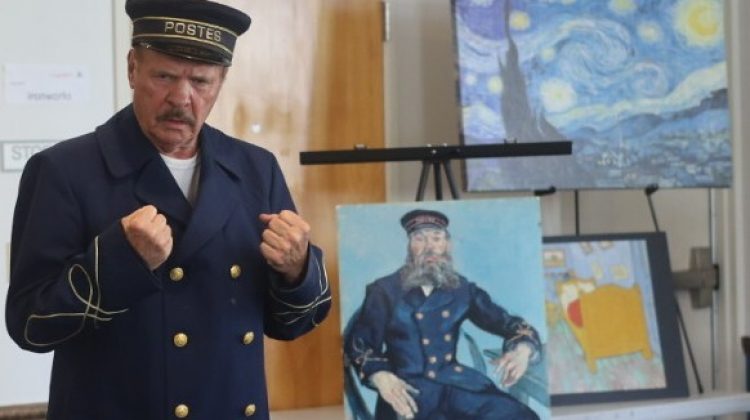SAUGUS — Actor Ted Zalewski captivated the audience at the library Saturday afternoon as he portrayed postman Joseph Roulin, a friend of famous artist Vincent Van Gogh.
Head of References Services Lisa LeJeune set the stage for Zalewski, saying, “Imagine the year is 1890, we are in a cafe in Auvers, France, a village outside of Paris.”
Zalewski started the show immediately in character, walking through the door in the coat matching the one Roulin was wearing in the portrait Van Gogh painted of him. He tipped his hat to the audience and greeted them in French.
In the show, Zalewski treats the audience as a stranger he has met in a cafe, sitting with them and telling them the tale of his friend Vincent. He even pours the audience their own glass of wine.
“Soon, I must catch my train back home to Arles. A glass of wine and a handful of bread make the journey go much easier. You, too, look like strangers. Is that so? You also look like good people. Is that true? Are you good people?” he said. Zalewski jokingly split his baguette in half next, offering it to the crowd.
He continued to tell the audience about Roulin’s home, Arles, and his wife, Augustine, as he spoke of his homesickness.
From there, he paints the audience the picture of Van Gogh’s life from the highs to the spiraling lows that eventually led to his suicide. He begins the story with the artist’s funeral, introducing the audience to the subject of his sorrow.
“Vincent’s coffin rests on top of a billiard table his tools, easel and brushes nearby. Vincent was a proud workman. Several of his paintings were nailed to the wall above his coffin. Red, blue, yellow – such a harmony of color. They formed a kind of halo over his resting place,” he said.
Zalewski’s voice switched scene to scene, going through the emotions that Van Gogh struggled with. Happiness, bitterness, loneliness, heartbreak, passion and anger flooded the room pulling the audience in. His actions were just as vibrant whether he was throwing a fist in the air, falling to a knee or hunching over and walking with a limp to portray an old man.
Zalewski speaks of Van Gogh buying his house in Auvers-sur-Oise. His room is still preserved to this day. It is after this purchase that the artist reaches his final spirals, his mental health becoming destructive.
“I can tell that Vincent is beginning to wear himself out. He lives only on bread and cheese. He stays up three nights in a row so he can paint a picture of the night cafe. He drinks 16 cups of coffee in a row so that he can reach the high yellow note, as he calls it,” he said. “What is the end of too much passion?”
Another famous artist, Paul Gauguin, enters the story as he moves in with Van Gogh with the hope of establishing a place where artists can live and work together.
“Gauguin brings order to the household,” Zalewski said. However, he describes Gauguin as a wolf and Van Gogh as a rabbit. “A wolf and a rabbit in the same lair. How dangerous,” he said.
He continued that the men initially got along well, inspiring each other, but soon things began to sour, leading to Gauguin leaving.
“Electricity fills the air. Vincent goes panicking. He prowls through the house that night, and finally, it was almost Christmas time, and Vincent, holding a razor in his hand, stalks Gauguin down the street,” he said.
Zalewski hunches over, creeping across the room with his hand raised acting as though he is Van Gogh waiting to lunge at Gauguin. Quickly, he makes his way across the room, standing now, and turning to where he once was, becoming Gauguin.
“Gauguin turns around and glares at Vincent. Vincent runs away,” he said.
It is in this moment that Van Gogh cuts off his ear and is found bloody in the morning. Zalewski tells the audience that from here Van Gogh seems to rise up again, painting the famous “Self-Portrait with Bandaged Ear.” This rise doesn’t last long.
“My friend Vincent is better than Icarus, but the pain does not stop,” he said.
Van Gogh is called crazy, and cabbages are thrown at him in the street.
“Madness frightens all of us. It is the shadow always lurking in our minds, but no one has the right to hurt a man crawling in the darkness of his shadow,” he said. A petition is signed, stating that Van Gogh is dangerous and his house is boarded up. From there he goes to an asylum and eventually paints “Starry Night.” After a year, Van Gogh eventually checks himself out of the asylum and returns to Auver under the guardianship of Dr. Paul Gachet.
“In 70 days, Vincent paints 70 paintings. What a rage of work. Vincent reminds me of a thunderstorm rolling across across the land,” he said.
Finally, all of Van Gogh’s passion, sadness and depression leads to his final moments, shooting himself in a field and crawling back to his room where he dies with his brother Theo by his side.
Zalewski bids the audience farewell, thanking them for the conversation before exiting the “cafe.”

